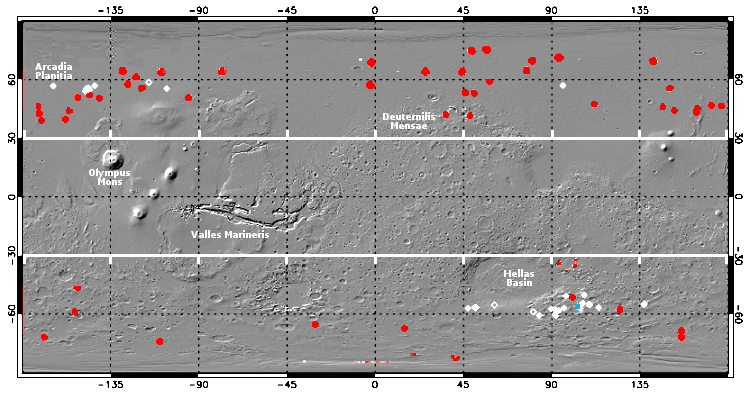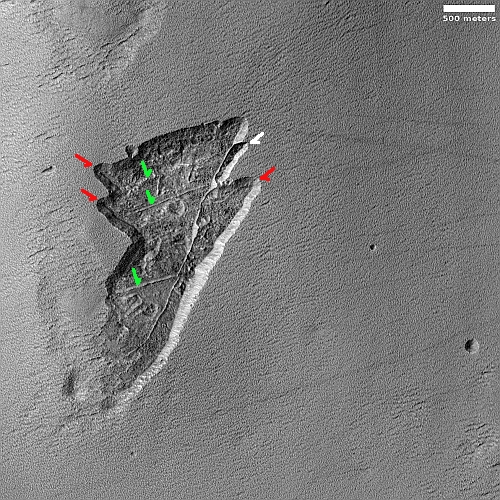An icy hollow on Mars
Cool image time! The photo to the right, cropped, reduced, and enhanced to post here, was taken on August 20, 2022 by the high resolution camera on Mars Reconnaissance Orbiter (MRO). It shows a somewhat typical example of the many ice scarps that scientists have identified in MRO pictures.
Though this is not a hard fast rule, most of the ice scarps so far found tend to have the steep cliff on the pole-facing side, with the scarp very slowly retreating towards the equator. In today’s example, the scarp where an ice layer in the cliff wall has been identified is indicated by the white arrow, though three sides of the hollow, on the east, north, and west sides, could all also have exposed ice.
Nor is that the only likely ice at this location at 56 degrees south latitude. The stippled plain surrounding the hollow clearly looks like an eroded ice layer, likely covered with a thin protective coat of dust to protect if from quickly sublimating away. The dark streaks across this surface are likely dust devil tracks.
As documented by the global map below, Mars is like Antarctica, a desert with water ice everywhere.

The map above, adapted and annotated by me from figures 4 and 12 from the paper “Widespread Exposures of Extensive Clean Shallow Ice in the Mid‐Latitudes of Mars”, show the areas on Mars where the evidence suggests ample and easily accessible ice, underground but close to the surface.
The blue dot marks the location of the hollow above, located amid a cluster of white dots and diamonds that indicate ice scarps with visible ice layers in their cliff faces. The red dots and diamonds indicate recent impact craters that temporarily exposed the underground ice layer that would normally not be visible. The size of all these locations is greatly exaggerated.
The two hatched lines at 30 degrees latitude, north and south, indicate the closest to the equator that scientists have detected evidence of glacial ice.
That paper also comments specifically on this particular hollow, adding the colored arrows:
Based on crosscutting relationships and the typical scarp geometry, the scarp initiated in the lower left part of the image and retreated approximately equator-ward. It maintained the same approximate orientation throughout, as shown by several scarp-parallel ridges (green arrows). However, retreat
may have been oblique rather than scarp-normal at times, since the scarp walls in the southern part of the pit are parallel but are not normal to the scarp. Multiple notches in the pit walls (red arrows) demonstrate that the scarp width varied over time and that the outer parts sometimes became inactive.
Essentially, the scarp retreated northward at an angle, apparently following some underground fault features indicated by those parallel ridges and the southwest-to-northeast ridge line that approximately bisects the hollow.
At present scientists do not know the actual rate of retreat. MRO images have so far not had the resolution to detect any changes over time.
On Christmas Eve 1968 three Americans became the first humans to visit another world. What they did to celebrate was unexpected and profound, and will be remembered throughout all human history. Genesis: the Story of Apollo 8, Robert Zimmerman's classic history of humanity's first journey to another world, tells that story, and it is now available as both an ebook and an audiobook, both with a foreword by Valerie Anders and a new introduction by Robert Zimmerman.
The print edition can be purchased at Amazon or from any other book seller. If you want an autographed copy the price is $60 for the hardback and $45 for the paperback, plus $8 shipping for each. Go here for purchasing details. The ebook is available everywhere for $5.99 (before discount) at amazon, or direct from my ebook publisher, ebookit. If you buy it from ebookit you don't support the big tech companies and the author gets a bigger cut much sooner.
The audiobook is also available at all these vendors, and is also free with a 30-day trial membership to Audible.
"Not simply about one mission, [Genesis] is also the history of America's quest for the moon... Zimmerman has done a masterful job of tying disparate events together into a solid account of one of America's greatest human triumphs."--San Antonio Express-News
Cool image time! The photo to the right, cropped, reduced, and enhanced to post here, was taken on August 20, 2022 by the high resolution camera on Mars Reconnaissance Orbiter (MRO). It shows a somewhat typical example of the many ice scarps that scientists have identified in MRO pictures.
Though this is not a hard fast rule, most of the ice scarps so far found tend to have the steep cliff on the pole-facing side, with the scarp very slowly retreating towards the equator. In today’s example, the scarp where an ice layer in the cliff wall has been identified is indicated by the white arrow, though three sides of the hollow, on the east, north, and west sides, could all also have exposed ice.
Nor is that the only likely ice at this location at 56 degrees south latitude. The stippled plain surrounding the hollow clearly looks like an eroded ice layer, likely covered with a thin protective coat of dust to protect if from quickly sublimating away. The dark streaks across this surface are likely dust devil tracks.
As documented by the global map below, Mars is like Antarctica, a desert with water ice everywhere.

The map above, adapted and annotated by me from figures 4 and 12 from the paper “Widespread Exposures of Extensive Clean Shallow Ice in the Mid‐Latitudes of Mars”, show the areas on Mars where the evidence suggests ample and easily accessible ice, underground but close to the surface.
The blue dot marks the location of the hollow above, located amid a cluster of white dots and diamonds that indicate ice scarps with visible ice layers in their cliff faces. The red dots and diamonds indicate recent impact craters that temporarily exposed the underground ice layer that would normally not be visible. The size of all these locations is greatly exaggerated.
The two hatched lines at 30 degrees latitude, north and south, indicate the closest to the equator that scientists have detected evidence of glacial ice.
That paper also comments specifically on this particular hollow, adding the colored arrows:
Based on crosscutting relationships and the typical scarp geometry, the scarp initiated in the lower left part of the image and retreated approximately equator-ward. It maintained the same approximate orientation throughout, as shown by several scarp-parallel ridges (green arrows). However, retreat
may have been oblique rather than scarp-normal at times, since the scarp walls in the southern part of the pit are parallel but are not normal to the scarp. Multiple notches in the pit walls (red arrows) demonstrate that the scarp width varied over time and that the outer parts sometimes became inactive.
Essentially, the scarp retreated northward at an angle, apparently following some underground fault features indicated by those parallel ridges and the southwest-to-northeast ridge line that approximately bisects the hollow.
At present scientists do not know the actual rate of retreat. MRO images have so far not had the resolution to detect any changes over time.
On Christmas Eve 1968 three Americans became the first humans to visit another world. What they did to celebrate was unexpected and profound, and will be remembered throughout all human history. Genesis: the Story of Apollo 8, Robert Zimmerman's classic history of humanity's first journey to another world, tells that story, and it is now available as both an ebook and an audiobook, both with a foreword by Valerie Anders and a new introduction by Robert Zimmerman.
The print edition can be purchased at Amazon or from any other book seller. If you want an autographed copy the price is $60 for the hardback and $45 for the paperback, plus $8 shipping for each. Go here for purchasing details. The ebook is available everywhere for $5.99 (before discount) at amazon, or direct from my ebook publisher, ebookit. If you buy it from ebookit you don't support the big tech companies and the author gets a bigger cut much sooner.
The audiobook is also available at all these vendors, and is also free with a 30-day trial membership to Audible.
"Not simply about one mission, [Genesis] is also the history of America's quest for the moon... Zimmerman has done a masterful job of tying disparate events together into a solid account of one of America's greatest human triumphs."--San Antonio Express-News


